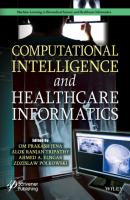Computational Intelligence and Healthcare Informatics. Группа авторов
Чтение книги онлайн.

Читать онлайн книгу Computational Intelligence and Healthcare Informatics - Группа авторов страница 26
Название: Computational Intelligence and Healthcare Informatics
Автор: Группа авторов
Издательство: John Wiley & Sons Limited
Жанр: Программы
isbn: 9781119818694
isbn:
Table 2.5 Models with hardware used and time required for training.
| Ref. | Dataset | Hardware and software platform used | Input image size | Time required for training |
|---|---|---|---|---|
| [47] | CheXpert | NVIDIA Geforce RTX 2080 Ti with 11GB memory. Python with Keras and TensorFlow | 224 × 224 pixels | - |
| [51] | Lung ultrasonography videos from Italy | RTX-2080 NVIDIA GPU | 1,005 frames | 11 hours |
| [46] | NIH Tuberculosis Chest X-ray dataset [18] and Belarus Tuberculosis Portal dataset [21] | Nvidia GeForce GTX 1050 Ti | 512 × 512 | 5–6 ms |
| [26] | ChestX-ray14 dataset | 8-core CPU and four TITAN V GPUs Pytorch 1.0 framework in Python 3.6 on an Ubuntu 16.04 server | 224 × 224 | - |
| [20] | ChestX-ray14 dataset | NVIDIA TITAN Xp GPUs Pytorch | 224 × 224 | 6 hours |
| [70] | ChestX-ray14 dataset | Dev-Box linux server with 4 Titan X GPUs | 224 × 224 | - |
| [5] | ChestX-ray14 dataset | Intel Core(TM) i7-6850k CPU 3.60GHz processor, 4TB of hard disk space, 7889 MB of RAM, and a CUDA-enabled NVidia Titan 11 GB graphics processing unit with python and Keras library on TensorFlow | 224 × 224 | - |
| [49] | ChestX-ray8 | NVIDIA GeForce GTX TITAN and PyTorch | 512 × 512 | 20 hours |
| [46] | NIH Tuberculosis Chest X-ray [18], Belarus Tuberculosis [A6] | Nvidia GeForce GTX 1050 Ti | 512 × 512 | 1 hour |
| [61] | Kaggle PSNA | Nvidia Tesla V100 and Nvidia K80 and Keras library of Python | 512 × 512 | 7 hours |
| [13] | St. Michael’s Hospital chest x-ray | 3 NVIDIA Titan X 12GB GPUs | 256 × 256 | 1 hour |
| [35] | NIH Tuberculosis Chest X-ray [18], Belarus Tuberculosis [A6] | Intel i5 processor with 32 GB of RAM, and a CUDA-enabled Nvidia Titan 312 GB GPU | 256 × 256 | - |
2.5 Summary
Considering scarcity of radiologists in less economically developed countries, deep learning models are used for medical imaging for detecting abnormalities in CXR images. There are 14 pathologies whose severity leads to mortality; therefore, many researchers try to detect all 14 pathologies. Generally, DL models are classified into two categories, namely, ensemble and non-ensemble models. Many researchers deployed parameters initialized from ImageNet dataset and then fine tune their proposed network as per the task. In order to deal with different issue, different pre-processing techniques are employed by the authors. The ChestX-ray14 dataset is the popular dataset which is experimented mostly as it contains large number of images with annotation. Cardiomegaly is the major chest pathology detected by many authors due to its spatially spread nature. We have also discussed factors affecting performance of models along with their significance. Finally, we have compared existing models on the basis of different parameters so that it will be easy to carry out future research to develop more robust and accurate model for the thoracic image analysis using deep models.
2.6 Conclusion and Future Scope
We found that it is tedious to obtain a good AUC score for all the diseases using single CNN. Doctors used to rely on a broad range of additional data such as patient age, gender, medical history, clinical symptoms, and possibly CXRs from different views. These additional information should also be incorporated into the model training. For the identification of diseases which have small and complex structures on CXRs, a finer resolution such as 512 × 512 or 1,024 × 1,024 may be advantageous. However, for preparation and inference, this investigation needs far more computational resources. In addition, another concern is CXR image consistency. When taking a deeper look at the CheXpert, it is observed that a considerable rate of samples have low quality (e.g., rotated image, low-resolution, samples with texts, and noise) that definitely deteriorate the model performance. Spatially spread abnormalities such as cardiomegaly and Edema can be localized more accurately. Due to shift variant nature of CNN, antialiasing filters are needed to improve the performance of CNN model.
Deep learning models should be able to integrate and interpret data from various imaging sources to obtain a better perspective on the anatomy of the patient in order to allow efficient analysis of patient scans. This could produce deeper insights into the nature and development of the disease, thereby offering a greater degree of understanding of the condition of patients by radiologists. Along with x-ray images other parameters such as heredity, age, and diabetes status, parameters can also be added to improve accuracy. Rather than going for ensemble and pre-trained models, pathology specific and data specific models can be implemented in future by combining good characteristics of existing models. Same models can also be used for detecting abnormalities in other region of body such as brain tumor, mouth cancer, and head-neck cancer. Novel deep learning models can be implemented for detecting post COVID СКАЧАТЬ